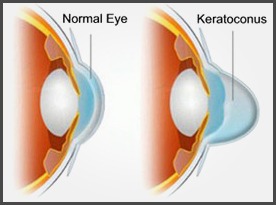Keratoconus is an eye condition that causes the clear front surface of the eye, known as the cornea, to thin and bulge forward. The bulging cornea affects the way light hits the retina at the back of the eye, causing distorted vision.
Keratoconus usually occurs during adolescence, or shortly after, and in most cases will stabilise by the age of 35. The symptoms begin slowly and can be hard to detect. Keratoconus may present as distorted or blurred vision and often patients report increased glare and light sensitivity.

Some evidence suggests that Keratoconus is a genetic condition and can be passed to a child if both parents carry the recessive gene. It cannot be treated with drugs, although glasses and contact lenses can help to reduce the effects on vision.
As the condition progresses, eye care professionals may recommend rigid contact lenses to alleviate further changes to the shape of the cornea. Corneal inserts may be advised, and in other cases corneal grafts may be recommended.

Recent research has investigated the link between rubbing of the eyes and keratoconus, and evidence suggests controlling “knuckle rubbing” with allergy drops and avoidance techniques may be important in long term outcomes.

